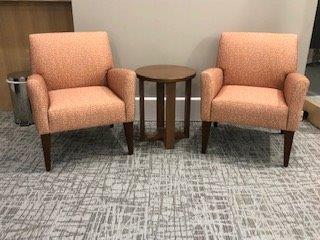1. It doesn’t matter how good something looks if it feels awful.
I have lost count of the times I have visited aged care homes and have seen the most beautiful chairs expertly chosen and laid out around the room. Inevitably, I take a seat and they are unbelievably uncomfortable. As hard as a rock. If you are choosing furniture, organise a trial with the supplier and sit in them before you order them. Better still, let your residents sit in them and be involved in the selection process.
Take note of:
- The back and seat cushioning. These need to feel soft enough to be comfortable, but not too soft that you get lost in it. It needs to offer functional support.
- The arm height: are they functional and comfortable?
It doesn’t matter how good something looks if it feels awful.

2. Is it easy for residents to lift out of?
We are often asked if the chairs meet ‘the height standard’ for aged care. This is an interesting question, as I’m not sure what the ‘standard’ height of an aged care resident is! In saying that, generally speaking, chairs that are higher than standard retail chairs are easier to lift out of.
Keep in mind the following:
- Seat height. The dimensions do matter. A seat of around 45-50cm is generally a good height.
- Seat depth. Unless you have a very tall resident, the seat shouldn’t be too deep.
- Suitable arms. By suitable, they need to be comfortable and not too low to be useful.
- Seat angle. Occupational therapists recommend that the residents thighs should be perpendicular to the floor, and that the knees should be in line with the hips. If the knees are higher, it will be harder to lift out of.

3. Choose a variety of chairs for your lounge areas.
Not all residents are going to be the same size, so choose different style chairs (in the same fabric, or complimentary fabric) to allow for your residents varying shape and size.

4. Tie the new furniture in with your existing furniture.
The one thing you can be sure of is that the furniture will all get mixed up. Our tip is to choose something different enough that you can identify where it belongs, but similar enough so that when it does get mixed up, it doesn’t look terrible.
We suggest you choose a similar style in the same colour, but with a different patterned fabric. Or the same pattern, but a different colour.

5. Choose dining chairs with an open or ¾ back.
Food will fall onto the chairs. Don’t risk getting it stuck in the back forever. Choose a chair that allows food to be swept out the back.
6. Vinyl seats.
This is especially important for dining chairs. They will get dirty. Even though most aged care fabrics can be cleaned and bleached, a vinyl can be wiped with a damp cloth quickly and easily. Cleaning staff are unlikely to clean fabric seats regularly with a bucket and sponge, which is what non-vinyl fabrics require.
You can choose a beautiful fabric for the back of the chair and complimentary vinyl for the seat.
A lot of customers are now choosing vinyl on lounge chair seats as well, to enable quick and easy cleaning if required.
7. Castors on dining chairs.
More and more residents require staff assistance to be moved in and out from the table.
Castors on the front of the dining chair make it easier to move the resident. This protects the health and safety of the staff as well as the chairs.

8. Light coloured timber furniture will wear better with age.
Most timber is naturally a blonde colour underneath the stain. When you choose a dark stain, and the furniture is consistently hit with walkers, vacuum cleaners or trolleys (which it will be) it will look awful in no time. The stain will be knocked off and the blonde will show through, highlighting the knocks.
If you choose either ‘clear lacquer’ or a light coloured stain, you will not notice the contrast with regular knocks.

9. Side table height should be the around the same as the height of the arm on the chair.
Residents can then just move their arm across to the side table for their cuppa, without the risk of having to lean down or over and possibly knocking it over.
10. Coffee tables need to be useful.
We regularly see a very small coffee table in the middle of a lounge room, that no one can reach and gets lost in the space. Coffee tables with shelves are great to hold things like magazines and books. Choose a coffee table to suit the size of the space.




















Comments